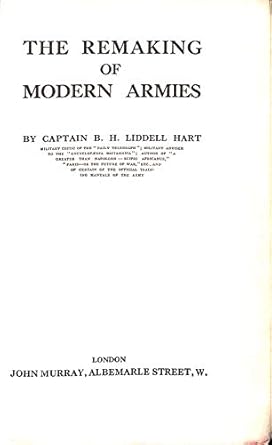The Remaking of Modern Armies

About
Summary
Exquisite
TOC
Details
Related
URL
Images
Overview
The Remaking of Modern Armies by Captain B.H. Liddell Hart, published in 1927, outlines Liddell Hart's theories on military strategy and army organization in the interwar period. The book is not just a reflection on the past but a forward-thinking analysis, advocating for mechanization, mobility, and a shift away from the static, attrition-based warfare that characterized World War I. Liddell Hart, a prominent military theorist, journalist, and historian, sought to define a more efficient and effective way of waging war, deeply influenced by his experiences in the First World War and his observations of its devastating consequences.The Remaking of Modern Armies is structured around Liddell Hart's core concepts of military strategy, tactics, and organization. He draws from his experiences in World War I, his analysis of military history, and his observations of technological advancements to argue for a fundamental rethinking of military doctrine.
Importance of Book
Influence on Military Thought: Liddell Hart's theories had a profound impact on military thought in the interwar period and beyond. His emphasis on mechanization, mobility, and the indirect approach influenced military leaders and strategists around the world.
Foresight Regarding Future Warfare: Liddell Hart accurately predicted the future of warfare, anticipating the importance of tanks, air power, and mobile operations. His ideas foreshadowed the blitzkrieg tactics employed by Germany in World War II.
Advocacy for Professionalism and Innovation: The book promoted a culture of professionalism and innovation within the military, encouraging officers to think critically about strategy and tactics and to embrace new technologies.
Emphasis on Efficiency and Economy: Liddell Hart's emphasis on efficiency and economy of force remains relevant in contemporary military planning, as military leaders grapple with limited resources and complex security challenges.
Challenging Established Doctrine: Liddell Hart challenged established military doctrine, encouraging a re-evaluation of traditional approaches to warfare and paving the way for new strategies and tactics.
Warning About Politicians: Author's warning about politicians willing to instigate wars, especially long term low level/intensity conflicts proves that author was not ignorant on what would end up as preferred ways of waging wars even in 1937.
Influence on Western Military Thought: Since author was a great influence on western military thought I now understand this proclivity of the West towards what might be called assassin-wars, striking down the perceived enemy after months and months of hungering them down and closing them off from the rest of the world (like was case with Iraq).
Key Themes
The Need for Military Reform: Liddell Hart stresses the need for comprehensive military reform to adapt to the changing nature of warfare.
The Importance of Technology: Technology helps the modern army.
Mobility as a Decisive Factor: Mobility gives an army a great advantage.
Efficiency and Economy of Force: Maximize the effectiveness of the army.
The Primacy of Strategy: Good strategy helps the army succeed.
Cultural Significance
A Reflection of Interwar Military Thought: The book reflects the debates and discussions surrounding military strategy and organization in the interwar period.
A Catalyst for Change: It acted as a catalyst for change within military establishments, prompting officers to rethink their assumptions and embrace new ideas.
A Source of Inspiration for Military Leaders: The book inspired military leaders around the world, influencing their thinking about warfare and their approach to military modernization.
A Foundation for Modern Military Doctrine: Many of Liddell Hart's ideas have become foundational principles of modern military doctrine.
Effects on Society
Influencing Military Policy: The book influenced military policy in several countries, particularly in Great Britain and Germany, where Liddell Hart's ideas were studied and implemented.
Promoting Military Modernization: It promoted military modernization, encouraging governments to invest in new technologies and adapt their armed forces to the demands of modern warfare.
Shaping Public Opinion on Military Matters: The book helped to shape public opinion on military matters, fostering a greater understanding of military strategy and the challenges of modern warfare.
Contributing to Military Successes: Some argue that Liddell Hart's ideas contributed to the military successes of the German blitzkrieg in World War II, although this remains a subject of debate among historians.
Conclusion
The Remaking of Modern Armies by B.H. Liddell Hart is a seminal work that outlines his theories on military strategy and army organization in the interwar period. The book's importance lies in its influence on military thought, its foresight regarding future warfare, and its advocacy for professionalism and innovation. Its key themes include the need for military reform, the importance of technology, mobility as a decisive factor, efficiency and economy of force, and the primacy of strategy. Its cultural significance stems from its reflection of interwar military thought, its role as a catalyst for change, and its foundation for modern military doctrine. The book had a lasting effect on country and society, influencing military policy, promoting military modernization, shaping public opinion on military matters, and potentially contributing to military successes.
Table of Content
\"The Remaking of Modern Armies\" by Captain B.H. Liddell Hart, published in 1927, is a significant work in military theory. Liddell Hart, a renowned military strategist, discusses the evolution of modern armies and the strategic lessons learned from recent conflicts.Here\'s a brief overview of the table of contents for the 1927 edition:Introduction: The Scope and Objective
The Historical Development of Modern Armies
The Impact of Technological Advances
Strategic Lessons from the Great War
The Evolution of Tactical Doctrine
The Role of the General Staff
The Influence of Military Leadership
The Future of Army Organization
The Integration of New Weapons and Methods
Conclusions and Recommendations
Title
The Remaking of Modern Armies
Author
Capt B H Liddell Hart
Name of Publisher
John Murray London
Publish Date
1927
Subject
New technologies and strategies of Army
Vintage
1901-1947
Edition
First
Category
Literary
Sub Category
Military
Rarity
RARE
